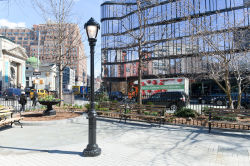Jackson Square
Jackson Square Park
One of New York City’s oldest parks, Jackson Square Park has a long and rather obscure history. The triangular shape of the park is a result of the diagonal route of Greenwich Avenue, the oldest known road in Greenwich Village. Greenwich Avenue originated as an Indian trail and was called the Strand Road by Dutch colonists. Forming the other two sides of the triangle, Eighth Avenue and Horatio Street date to 1811, when the New York legislature approved the Manhattan street grid, known as the Commissioner’s Plan. This triangular parcel at Greenwich Avenue, Eighth Avenue, and Horatio Street appears without a name on the Commissioner’s Plan.
When and why the site came to be called Jackson Square is unclear. Most likely it was named after Andrew Jackson (1767-1845), the seventh President of the United States. Born at Waxhaw Settlement, on the border of North and South Carolina, Jackson was elected to Congress in 1796 and served in the War of 1812. “Old Hickory”, as he was known, emerged as a national hero who was very popular with the leaders of Tammany Hall, New York’s most influential Democratic organization. With Tammany’s support, Jackson won the presidential elections of 1828 and 1832. On October 30, 1832, a hickory tree was planted in front of Tammany Hall, and its roots were nourished with the contents of a barrel of beer.
In 1858 the Mozart Hall Democratic faction split off from Tammany, when Mozart candidate Fernando Wood was elected Mayor of New York. Between 1859 and 1863, members of the Mozart Hall organization held their gatherings at Jackson Hall, a building that formerly stood at 2 Horatio Street on the corner of Greenwich Avenue. The building was one of dozens that faced onto the triangular parcel of open space now - and perhaps then - known as Jackson Square.
The city acquired the land in 1826. The earliest known reference to Jackson Square appears in the Second Annual Report of the Board of Commissioners of the Department of Parks in 1872. According to the report, Jackson Square was one of twenty-nine properties mapped and improved as parkland by the City. At Jackson Square, the following improvements were made by May 1872: “5,900 square feet walks graded/103 cubic yards masonry in foundations/460 lineal feet railing/462 lineal feet coping/6 lamp-posts furnished and set.”
In 1887, Mayor Abram S. Hewitt promoted a citywide effort to improve public access to the parks and squares that were entirely enclosed by iron fencing. Parks superintendent Samuel Parsons Jr. and consulting architect Calvert Vaux collaborated on a new design for Jackson Square. In an 1892 article for Scribner’s Magazine, Parsons described the central area as “a great bouquet of brilliant flowers and leaves.” He noted proudly, “The neighborhood of this park is respectable but populous, and it is wonderful on a warm evening to see the dense masses of people that crowd the park benches and smooth asphalt walks.”
In 1913, Parks gardeners planted a new school garden plot at Jackson Square and left its upkeep to the “little farmers” in the neighborhood. The park underwent renovations in the 1930s, when seventeen pin oaks were planted on the perimeter, the shower basin was replaced by a new wading pool, and new benches were installed. The park remained substantially unchanged for over fifty years, until a capital reconstruction project was completed in 1990. It included planting new greenery and restoring the historic iron fencing and benches. The centerpiece, a new cast-iron fountain with planters and a granite base, evokes the 19th-century origins of Jackson Square Park.
Check out your park's Vital Signs
Clean & Safe
Green & Resilient
Empowered & Engaged Users
Share your feedback or learn more about how this park is part of a
Vital Park System







